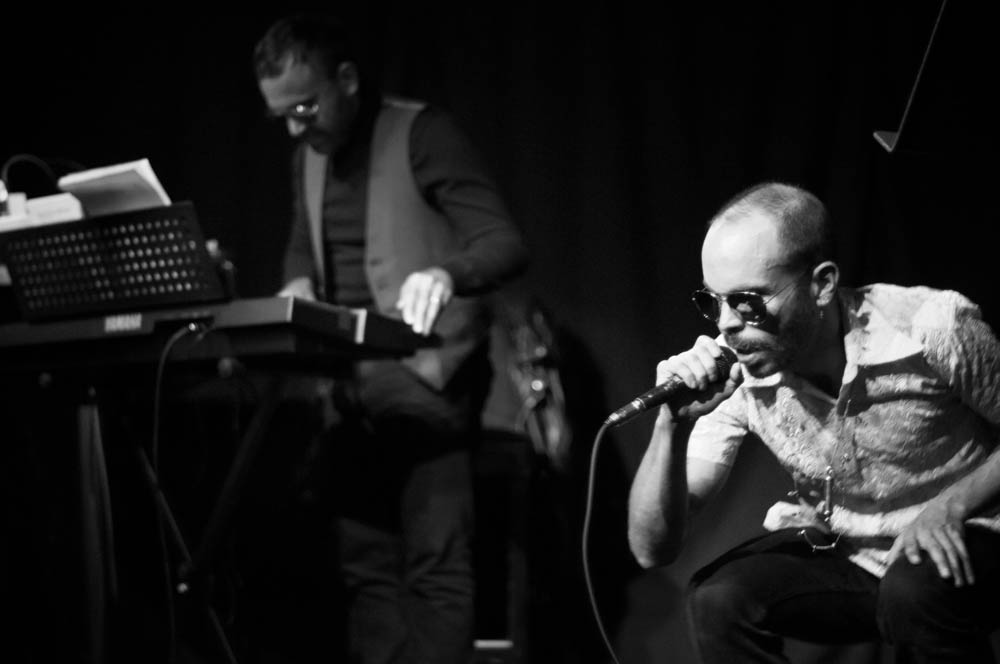Donato Mancini and Gabriel Saloman
Documentation by Jon Vincent for VANDOCUMENT

Copyright © 2012. All Rights Reserved.




Documentation by Jon Vincent for VANDOCUMENT
LeanneJ + My Name is Scot’s guerrilla poetry intervention in Vancouver’s Victory Square
Sept. 21 2013
Photos by Jürgen Fritz
 Well folks, last night was the first night for Live 2011! An auspicious start to what should prove to be a powerful and fun-filled festival.
Well folks, last night was the first night for Live 2011! An auspicious start to what should prove to be a powerful and fun-filled festival.
Fortner Anderson kicked things off, reciting the long poem, “Drifting into Fire”. The piece is one of three from a cycle called “Annunciations”, which each stem from investigative reports of modern disasters. Drawing from NASA’s accident report on the Space Shuttle Columbia, Anderson’s dynamic delivery shifted rapidly between ecstatic and mechanistic. At the most intense points of Anderson’s performance, it felt as if words were being forced from his mouth, like they could barely squeeze themselves out. Fitting, given that his subject is catastrophe at a scale that is at the very limits of what we can express or fathom. By truly considering the details outlined in these reports, Anderson saves these contemporary events from dry factuality. Our collective experience of tragedy takes on the feeling and gravity of something closer to Blake instead of the numbness of a newsfeed.
Following was Dana Claxton performing The Elsewhere with the help of Sam Bell. Central to this piece was a vessel made of hide, brightly painted with a long fringe at the bottom. Sam, who has collaborated with Claxton on several films, mentioned later that Claxton has a collection of such special objects. Despite the predominant position given to this beautiful container, it remained untouched for the majority of the performance. Instead a delicately balanced space was slowly built around the object, using stones, gestures and sound.
The piece proceeded in a gratifying 4/4 time, with Claxton moving backwards, eyes shielded from sight. Four bags of large grey stones were emptied on the floor. Four pairs of stones were each struck four times and laid out to make four paths radiating from the centre of the space. Four new bags of rocks were each dropped four times, the gesture creating a forceful and heavy sound, then emptied on the floor. Polished stones were revealed in red, black, pale yellow and white.
When Claxton finally approached the container, she began for the first time to move forward, circling the room and shaking the vessel so its contents rattled. A final action, the container’s contents were poured out in the centre of the room, revealing rainbow-hued abalone shells and handfuls of turquoise. Surprise at the sudden unveiling of this colourful bounty. A song is played on the stereo, traditional, aboriginal, female, and the audience is invited to take with them a “token of mother earth”. We are left with a gift of beauty.
This place, this Elsewhere that Claxton created last night, conveyed a specific conception of space, an ‘Indianized’ space. The materials and structure of her piece invoke a space that is organic, natural, harmonious. By offering us the materials of her piece, she implies a space that can shift and travel, as well as a space of sharing.
Claxton’s performance was nicely balanced by the cheeky humour of Jean Dupuy, who presented three pieces in sound and video. In B. versus B., a ‘stuttering’ author plays Beethoven’s Sonata #9 and Brahms’ Sonata #3 out of two separate speakers as images of the venerable composers slowly revolve on two back-to-back laptops placed on the floor. Not only were the two poor B.’s pitted against each other, but they also had to face the trial of presentation through digital technology. Some (unintentional?) audio glitches added to the stutter of the piece. Brahms’ gaze remained sulkily fixed on the mouse cursor that graced the laptop screen.
Next, a performance with the lighthearted spirit of Chaplin, preserved on 16mm film. Shot in 1976 from a bird’s-eye view, Dupuy and his wife stride towards each other in the middle of the street. They meet in the centre of an intersection and embrace. The camera zooms as they strip and exchange clothes. She has big, light yellow undies; I think his drawers are black. They fumble around a bit, dress, and as a final touch, exchange eyeglasses. Arms around each other’s waist, they walk merrily down the street. The couple turn a corner, and are gone. Simple and charming.
The final piece was a sound work of the train from Paris to Bordeaux, at the time the fastest train in France. Recorded using the train’s toilet bowl to amplify the sound, the Western Front’s audience was treated to fifteen minutes of this hours long piece. Dupuy recommended that the audience lie on the floor to enjoy the vibrations from the sound waves. Some dutifully complied though others were put off by a warning that the sound would be very loud. Despite this notice, when I laid down I found the irregular yet repetitive overtones of the moving train acted as a sedative to my prone mind and body. As I enjoyed the calming effect of these mild tremors across my back and legs, I distinctly felt the footsteps of people quietly exiting the room, bringing to a close the first night of the Biennale.
– stacey